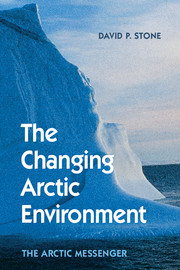Book contents
- Frontmatter
- Dedication
- Contents
- Acknowledgements
- Acronyms
- 1 Personal Beginnings
- PART I THE CHANGING ARCTIC
- PART II WORKING TOGETHER
- PART III WHAT IS THE PRESENT STATE OF KNOWLEDGE?
- 4 Radioactivity
- 5 Heroic Efforts
- 6 Acidification and Arctic Haze
- 7 Stratospheric Ozone Depletion
- 8 Persistent Organic Pollutants and Heavy Metals (Including Mercury)
- 9 Conducting Marine Science in the Arctic
- 10 Climate Change in the Arctic
- PART IV WHAT DOES ALL THIS MEAN?
- Appendix I The Intergovernmental Panel on Climate Change (IPCC)
- Appendix II What Will Happen in the Future If We Do Nothing or If We Try Very Hard to Aggressively Reduce GHG Emissions: Projected Change Under Different Emission Scenarios
- Appendix III Some Geophysical Background Notes Related to Climate and Weather
- Appendix IV Orbital Forcing
- Appendix V The Concept of Commitment
- Bibliography
- Credits
- Index
10 - Climate Change in the Arctic
from PART III - WHAT IS THE PRESENT STATE OF KNOWLEDGE?
Published online by Cambridge University Press: 05 February 2015
- Frontmatter
- Dedication
- Contents
- Acknowledgements
- Acronyms
- 1 Personal Beginnings
- PART I THE CHANGING ARCTIC
- PART II WORKING TOGETHER
- PART III WHAT IS THE PRESENT STATE OF KNOWLEDGE?
- 4 Radioactivity
- 5 Heroic Efforts
- 6 Acidification and Arctic Haze
- 7 Stratospheric Ozone Depletion
- 8 Persistent Organic Pollutants and Heavy Metals (Including Mercury)
- 9 Conducting Marine Science in the Arctic
- 10 Climate Change in the Arctic
- PART IV WHAT DOES ALL THIS MEAN?
- Appendix I The Intergovernmental Panel on Climate Change (IPCC)
- Appendix II What Will Happen in the Future If We Do Nothing or If We Try Very Hard to Aggressively Reduce GHG Emissions: Projected Change Under Different Emission Scenarios
- Appendix III Some Geophysical Background Notes Related to Climate and Weather
- Appendix IV Orbital Forcing
- Appendix V The Concept of Commitment
- Bibliography
- Credits
- Index
Summary
“There in the north where ice, water and air mingle is, without doubt, the end of the earth. There I have seen the lung of the sea.”
Pytheas, fourth century BCEUntil the mid-nineteenth century, the Great Powers were obsessed with discovering whether ships could pass from the Atlantic to the Pacific and vice versa through or north of North America. In pursuit of this obsession, many ships and lives were lost in the eighteenth and nineteenth centuries. Included were the entire crew of the famous Franklin expedition that sailed into oblivion in 1845. It was the unsuccessful search for Franklin, launched from the Atlantic and the Pacific, that essentially led to the discovery and mapping of the Northwest Passage, but it was not until 1906 that a ship managed a complete transit. That honour went to the Norwegian Roald Amundsen in the little sloop Gjöa. His three-year voyage was completed in 1906, but the lesson learned was that even at the most favourable time of year, the passage had no commercial potential. As late as the 1970s, a transit could only be attempted by a heavy icebreaker in late summer or with the constant assistance of one or more icebreakers (as was the case with the experimental transit made by the tanker SS Manhattan in 1969). The single exception came when nuclear submarines began to patrol the Arctic Ocean.
You can imagine my excitement when, in September 1979, I sailed to the Northwest Passage on the maiden voyage of the ice-breaker Kigoriak. Its design owed much to features developed in Finland that were quite revolutionary for Canada. It was built on the Atlantic coast in New Brunswick but was to operate in the Beaufort Sea. At exactly the same time but coming in the other direction was the more traditionally designed Sir John Franklin – also on its maiden voyage.
- Type
- Chapter
- Information
- The Changing Arctic EnvironmentThe Arctic Messenger, pp. 194 - 264Publisher: Cambridge University PressPrint publication year: 2015



